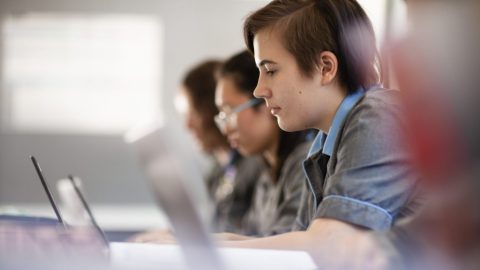Wellbeing – Managing the Transition Back to School

In the same way that the transition to the Learn@Home program created unique challenges to wellbeing for both parents and students, the transition back to school may raise concerns for parents and for the girls as they prepare to return to what will be yet another “new normal”. There are a number of things that can assist with this transition back to school.
Routine, again
Just as maintaining routine throughout the Learn@Home journey was important, establishing a back to school routine is one of the most crucial aspects of easing students into the rhythm of life back at school. For many girls, sleep patterns have changed during the period of isolation, and returning to the pattern required for school is particularly important. Students will be significantly more physically tired once they are again learning at school, so going to bed at an appropriate hour and waking at the time required to get to school, will assist with a smooth return. If students have been wearing sports uniform, every day, it might now be time to put on a full school uniform and see how that feels. If students have been retreating into their bedrooms for most of the day, having regular meal times with other family members, being involved in other routine activities such as exercise, grocery shopping or other household tasks may provide a way of transitioning out of isolation and back in to a more normal school routine.
Focus on the why
Parents can support their girls in returning to school by focussing on the positives associated with being on site at school and the reasons why returning to campus is important. For some students this will be easy – they have been longing to return to friends and to the teaching in the classroom. For others, they may require support to reflect on the benefits of returning to school. For some girls this may be seeing friends who have missed them, for some, it might be making contact with supportive teachers, and for others, returning to activities that they have previously enjoyed. Parents can be realistic about the fact there may be some hiccups along the way and can reassure their girls that they will be there to support them in navigating those bumps, but maintaining a positive attitude with children is vital.
School as a safe place
An important part of supporting a student’s return to school is to promote a sense of safety and security in that environment. Parents are encouraged to speak with their daughters and read through the Return to School Information booklet to ensure that they are aware of the steps needed to keep themselves and others safe, as well as what the School is doing, and reinforce the steps your family is taking as restrictions ease.
Create the “new normal”
In many ways, returning to school may feel like a “restart” to the year rather than a “return”. Friendships may have changed during the period of isolation, requiring students to explore new connections. Reaching out to different students prior to starting school can assist pave the way for these connections to renew on return. Study may have been challenging while at home, so a fresh approach, with new goals for learning and for what students want to achieve may be valuable.
For senior students, there may be a feeling like the year has not started the way they anticipated, and that it is “too late” for them to achieve as they had planned. This is not the case. Every student has encountered the same beginning, so the playing field remains even, and there is plenty of time for them to achieve their goals. For all students who are worried about study, we encourage them to talk to teachers and develop a plan to move forward, rather than giving up or working frantically without a clear understanding of what will be most effective. It will also be valuable to review these plans, and ensure that they are still working as students become more settled to being at school again.
Moving out of the “comfort zone” when anxiety is high
For students who are finding it more difficult to manage their worries about returning to school, two strategies are especially important for families – encouraging realistic thinking to replace anxious thoughts, and reducing avoidant behaviours.
Anxious students often over-estimate the risk of a feared event occurring. Challenging this overestimation by offering fact based information about situations, looking at the realistic likelihood of feared events occurring, and developing a plan of how to tackle difficult situations can support the student in feeling like they have more control. Parents are encouraged to discuss what students might say in different circumstances, who can support them at school, and how they might access that support if needed.
Supporting students to come up with ways to move themselves out of their comfort zone prior to returning to school can assist with managing avoidant behaviours. It is important that these things be practised repeatedly. Working each day to do more to challenge avoidant behaviours will encourage the student to feel more confident and better able to manage while at school.
If a student is really stuck, then meeting with their Head of Year, or other wellbeing staff, can support a student to devise a way to step out of the ‘bubble’ that Learn@Home has created for some students, and back into the classroom.


